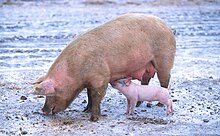Hog (swine)
| Domestic pig | |
|---|---|
 |
|
| Female (sow) with piglet | |
|
Domesticated
|
|
| Scientific classification | |
| Kingdom: | Animalia |
| Phylum: | Chordata |
| Class: | Mammalia |
| Order: | Artiodactyla |
| Family: | Suidae |
| Genus: | Sus |
| Species: | S. scrofa |
| Subspecies: | S. s. domesticus |
| Trinomial name | |
|
Sus scrofa domesticus Erxleben, 1777 |
|
| Synonyms | |
|
|
|
Global pig stocks in 2014 |
|
| (million) | |
|
|
474.1 |
|
|
67.7 |
|
|
37.9 |
| World total | 986.6 |
| Source: UN Food & Agriculture Organisation (FAO) |
|
The domestic pig (Sus scrofa domesticus or Sus domesticus), often called swine, hog, or pig when there is no need to distinguish it from other pigs, is a large, even-toed ungulate. It is variously considered a subspecies of the wild boar or a distinct species. The domestic pig's head-plus-body-length ranges from 0.9 to 1.8 m (35 to 71 in), and the adult can weigh between 50 to 350 kg (110 to 770 lb). Compared to other artiodactyls, its head is relatively long, pointed, and free of warts. Even-toed ungulates are generally herbivorous, but the domestic pig is an omnivore, like its wild relative.
Domestic pigs are farmed primarily for the consumption of their meat called pork. The animal's bones, hide, and bristles are also used in commercial products. Domestic pigs, especially the pot-bellied pig and micro pig, are sometimes kept as pets.
The domestic pig typically has a large head, with a long snout which is strengthened by a special prenasal bone and a disk of cartilage at the tip. The snout is used to dig into the soil to find food, and is a very acute sense organ. The dental formula of adult pigs is 3.1.4.33.1.4.3, giving a total of 44 teeth. The rear teeth are adapted for crushing. In the male the canine teeth can form tusks, which grow continuously and are sharpened by constantly being ground against each other.
...
Wikipedia
